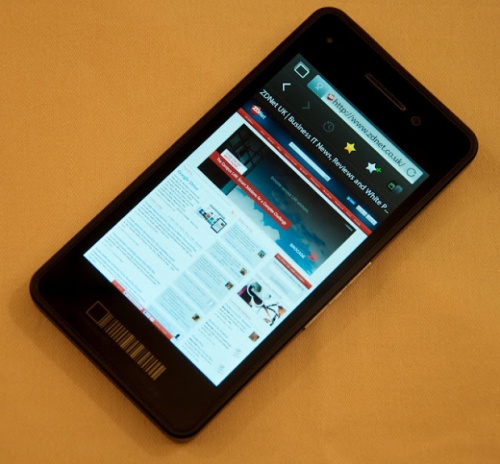RIM unwraps BlackBerry 10 toolkits and test devices

Research In Motion has unveiled the next steps in its transition from the Java-based BlackBerry OS to the QNX-powered BlackBerry 10 platform, including a prototype device running an early version of the upcoming operating system.

RIM has doled out 2,000 prototype handsets dubbed the Dev Alpha, running an early version of BlackBerry 10. Image credit: Simon Bisson
The Canadian mobile hardware maker released new software development kits, as well as the developer-only Dev Alpha test device, on Tuesday at the BlackBerry 10 Jam event in Orlando, Florida. The developer gathering runs alongside BlackBerry World.
"Developers can use this first beta of the tools to get started building apps for BlackBerry 10, and as the tools evolve over the coming months, developers will have access to a rich API set that will allow them to build even more integrated apps," Christopher Smith, RIM's head of handheld application platform and tools, said in a statement.
The releases are a sign that RIM, which has been criticised in the past for its laggardly progress, is closing in on launching a BlackBerry 10-based handset. At the end of March, the company's head of developer relations, Alec Saunders, said, "It's tangible evidence of the company making progress to finally shipping the device."
The new BlackBerry 10 tools, available as a free download from the BlackBerry developer website, include support for RIM's QT-based Cascades user interface and for both native C++ and HTML5-powered applications. The tools are being released initially using the Eclipse IDE. However, a limited beta of a Visual Studio-based tool has been made available to gaming developers to support existing cross-platform gaming tools, RIM's director of app platform and tools product management, Tim Neil, said in a pre-briefing.
Neil noted that RIM will be "adding deep integration through the beta. We're starting with the UI framework. All the essentials, building blocks and storage are here".
RIM has introduced the BlackBerry Music Gateway, an NFC-enabled device designed to play music stored on BlackBerry phones. Image credit: RIM
While user interface development is done on the QML declarative framework, developers will also be able to use JavaScript to construct UIs for native applications. The C++ BlackBerry 10 Native SDK will include support for integration with the core BlackBerry personal information management (PIM) features and applications such as BlackBerry Messenger, as well as with new hardware options such as near-field communication (NFC).
In addition, the company delivered BlackBerry 10 WebWorks SDK. The new release of the WebWorks HTML5 programming environment has support for BlackBerry 10 and for native-like UI features via an open-source JavaScript UI library. Unlike earlier versions of WebWorks, which used Java and AIR wrappers for HTML code, the BlackBerry 10 release has a set of native JavaScript APIs, which are meant to improve performance and give developers more access to device features and capabilities.
Beyond this, RIM plans to add BlackBerry 10 user interface components to the popular JQuery Mobile JavaScript libraries. The toolsets released on Monday also include BlackBerry 10 SDKs for Adobe Air and Android apps.
Introducing the BlackBerry 10 UI in a keynote speech on Tuesday, chief executive Thorsten Heins said the company is "taking time to make sure we get this right". He also said that RIM had chosen "the hard choice and the hard road" in working to deliver its own platform.
Overall, the UI extends the features found in the PlayBook 2.0 messaging application, allowing users to slide from view to view without leaving their original context. RIM's European head of software portfolio Vivek Bhardwaj described the feature as "floating through menus" during an on-stage demonstration. All the applications remain running in the background, taking advantage of QNX's multi-tasking features.
In addition, a new touch keyboard learns user actions, adapting to the user's style of typing. Also, the PlayBook 10 camera application has a video capture buffer to hold image data from before you touch the screen to take a picture, letting you scrub back and forwards to pick the image you want.
Dev Alpha device
The Dev Alpha device provides a target for developers building for a BlackBerry 10 smartphone. Describing it as having "basic hardware and a basic OS, but with the BlackBerry 10 SDK", Neil said the prototype's OS and tools will be updated regularly before BlackBerry 10 is launched in late 2012.
A 4.2-inch device with a 1024 x 768 display, the Dev Alpha runs a pre-release version of the BlackBerry 10 OS with a similar look and feel to RIM's existing PlayBook platform. The company is distributing 2,000 of the devices to developers at its Orlando gathering.
Separately, RIM introduced the BlackBerry Music Gateway, an NFC-enabled device designed to play music stored on BlackBerry and other Bluetooth-capable hardware through home and car music systems.
The use of NFC technology simplifies device pairing, meaning people can use a simple tap to connect a BlackBerry and a Music Gateway. The Gateway supports A2DP and AVRCP Bleutooth profiles, and will ship in June, the company said.
Get the latest technology news and analysis, blogs and reviews delivered directly to your inbox with ZDNet UK's newsletters.